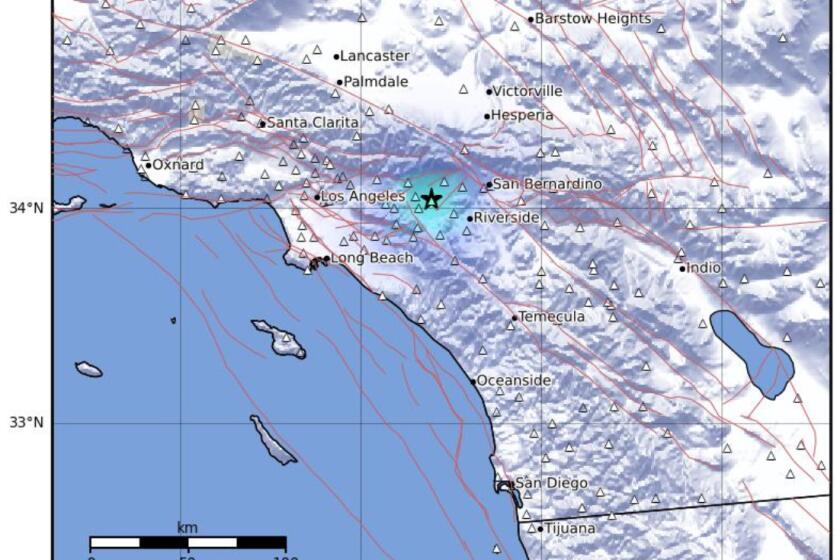Earthquake: The Long Road Back : New Mobile Home Rules Considered : Damage: Nearly 10% of such dwelling units in L.A. County were rendered uninhabitable by the quake. Some call for new bracing requirements.
Nearly 10% of all mobile homes in Los Angeles County have been declared uninhabitable as a result of earthquake damage, sparking renewed interest over whether costly safety measures should be required by the state.
Of 51,062 mobile homes in parks in Los Angeles County, 4,947 were damaged by the magnitude 6.6 quake to the extent that they are not livable, said Travis Pitts, deputy director for codes and standards for the California Department of Housing and Community Development, which oversees mobile homes.
“Most of them tumbled all the way off their support systems onto the ground,” Pitts said. “Some shifted on their foundations enough that they are considered dangerous.”
A total of 184 were burned to the ground in fires fueled mostly by ruptured gas lines, one of which took the life of a 92-year-old woman at Sunburst Park Mobile Homes in Chatsworth.
On Monday, Mayor Richard Riordan toured three fire-damaged mobile home parks in Sylmar with City Councilman Hal Bernson, and both called for heightened seismic safety measures.
“The one thing I’ve noticed is that most of this could have been avoided with some common sense measures,” Riordan said. “We’ll see what we can learn from this.”
Pitts said changes in safety standards are being drafted.
Although the state housing department has long favored requiring restraints to help keep mobile homes in place during earthquakes, strong opposition over the cost--estimated at up to $3,000 per mobile home--and the laborious process of justifying new regulations has kept such measures unrealized, Pitts said.
“It’s an issue of priorities and resources,” Pitts said. “I think earthquake restraints will take a higher priority for us now, but I still don’t have the staff or the resources to finish the regulation process right away.”
Joining in support for added safety requirements is the state Seismic Safety Commission.
Last week, in a preliminary report surveying the damage, the commission recommended that all mobile homes in California be secured to foundations on installation by July 1, 1995. In addition, the commission proposed that all mobile homes sold after Oct. 1, 1995, be anchored to foundations.
To place new requirements on mobile homes, the department must conduct exhaustive hearings and answer all concerns from the public to satisfy the staff of the Office of Administrative Law, which approves new regulations, Pitts said.
The department proposed mandatory “sawhorse-type” supports twice during the 1970s, Pitts said. But they were opposed by the Golden State Mobilehome Owners League, the state’s only association of mobile home residents, on the grounds that the cost of installing supports--usually in the $800-$3,000 range--would keep people of lower incomes out of the market.
The devastation of the Northridge quake, plus a change in league leadership, could result in a change in that position.
“We certainly don’t oppose restraints now,” said Golden State Vice President Pat Lowery, whose mobile home slid from its foundation during the quake. “Anything that will save our homes, we should do.”
*
Part of the problem, said Tony Hadley, vice president of the Manufactured Housing Institute, a national trade association, is that restraints used in states prone to hurricanes and tornadoes may not prevent mobile homes from slipping off their foundations during an earthquake.
“California is actually way ahead when it comes to safety standards,” Hadley said. “They have at least done most of the necessary research.”
There also have been proposals to require that mobile homes come equipped with devices that automatically shut off gas in case of an earthquake or ruptured gas line, Pitts said, but state officials and utility companies have been unsatisfied with their design.
Most of the damaged homes in the San Fernando Valley and outlying areas will be livable once they are lifted back onto their foundations by using cranes or hydraulic jacks, Pitts said.
But it may be weeks before thousands of mobile home dwellers--many of whom are senior citizens--can begin repairs.
Janet P. LaCoe, 57, who lives alone at Northridge Mobile Home Park, said a close call during the earthquake persuaded her to install some sort of safety brace under her home once it is replaced.
“My steps came off and blocked my door,” LaCoe said. “I got out through a window but if there had been a fire, I might not have gotten out. And there are a lot of older ladies here who are lucky they made it at all.”
John Quick, who suffered about $20,000 in damage in his home at the Tahitian Mobilehome Park, said he, too, would support mandatory restraints.
“I was very surprised that my home didn’t stay up better than it did,” Quick said. “They should require quake bracing because I don’t think people will do it on their own.”
State inspectors going park to park during the past two weeks found mobile homes next to their foundations or tilted, supports sticking through floors and ashes where homes once stood.
The survey by Pitts’ department also found 559 of Ventura County’s 9,425 mobile homes unlivable.
More to Read
Sign up for Essential California
The most important California stories and recommendations in your inbox every morning.
You may occasionally receive promotional content from the Los Angeles Times.










